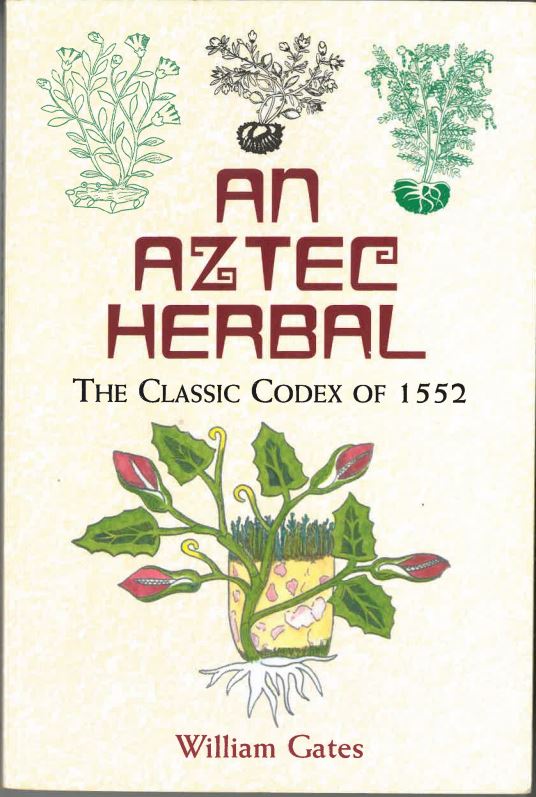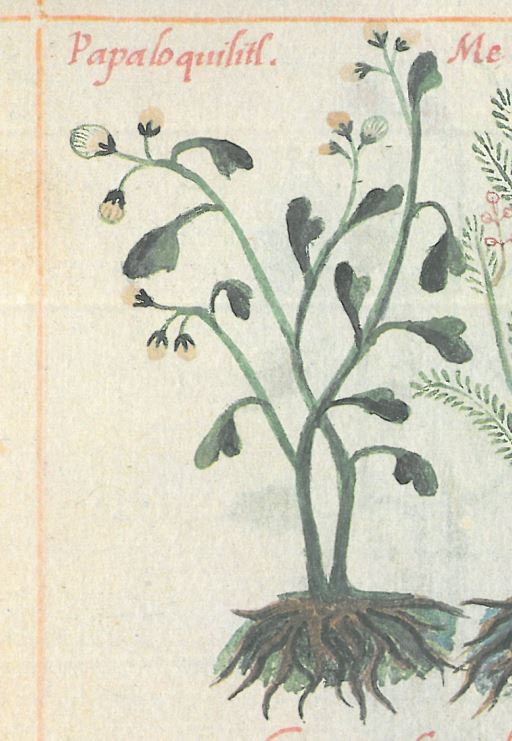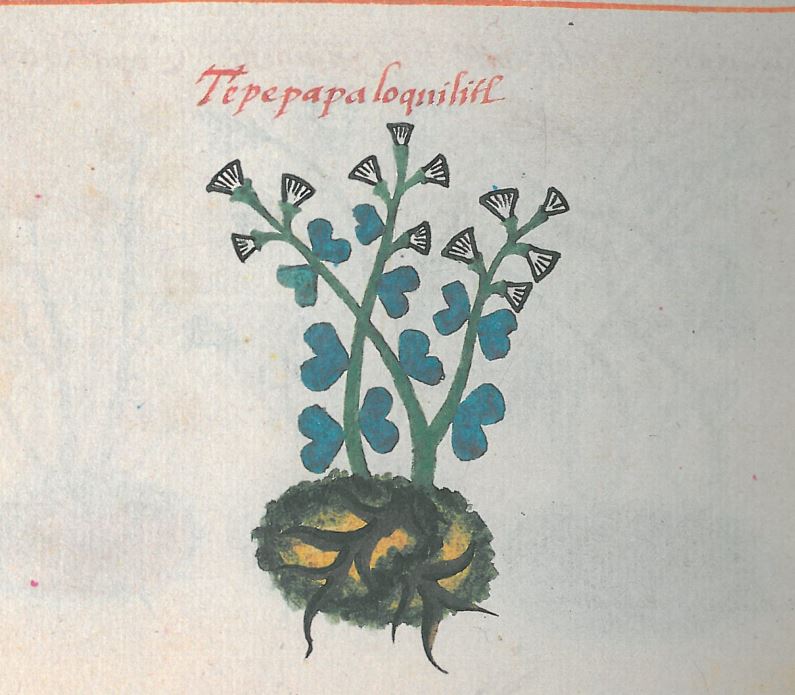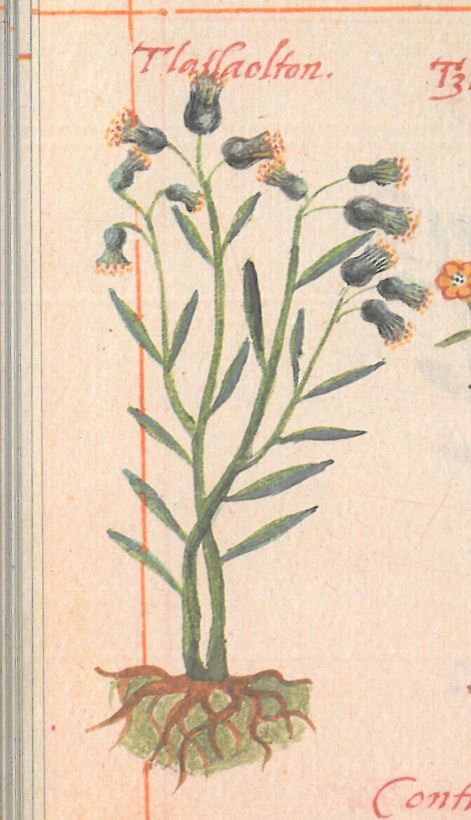

The first written references to papaloquelite (papaloquilitl) appear in the Libellus de Medicinalibus Indorum Herbis (“Little Book of the Medicinal Herbs of the Indians”) or more commonly the Codex de la Cruz-Badiano (Badianus Manuscript) . This text was written by Martín de la Cruz in the Colegio de Santa Cruz de Tlatelolco (1) in 1552 and then translated into Latin by Juan Badiano. The book is also called the Codex Barberini after Cardinal Francesco Barberini, who had possession of the manuscript in the early 17th century. It is the first illustrated and descriptive scientific text of Nahua medicine and botany produced in the Americas. It is a significant text in the history of botany and the history of medicine. In the year 2000AD William Gates published “An Aztec Herbal: The Classic Codex of 1552” which was an English translation of the Libellus de Medicinalibus Indorum Herbis as published by the Maya Society in 1939.
- The Colegio de la Santa Cruz de Santiago Tlatelolco was the first institution of higher education in America designed specifically for indigenous peoples. It was the most important New Spain centre of science and arts during the first half of the 16th century. The school began in 1533 when the Franciscans began teaching Latin grammar to the indigenous people. The College was officially inaugurated in 1536, just eight months after the arrival of the first viceroy of New Spain. In 1546, the school passed from Franciscan control to be completely administered by indigenous people. Eventually the school, beset by financial and economic problems, failed and ceased to function as an institution in the mid-1570s.




Some of the herbs in the text are (or are they?) relatives of papalo. The two below, Tlatlaolton and Ayauhtonan (Ayauhuatona) both bear resemblance to the porophyllum species through their leaf and flower structure (both seen to be narrow leaved varieties of poreleaf.


Check out Tlatlaolton. Which Porophyllum Are You? for more information on this herb.


Check out Ayauhtona. Another Poreleaf? for more information on this herb.
The medicinal uses of two papalos (papalo-quilitl and mountain papalo) are listed in the Badianus Manuscript.




Both of these descriptions make notations regarding a “1790 Hern.” reference text. The text being this…..
Hernández, Francisco (1959 – 84) Historia natural de Nueva España. 7 Volumes. Universidad Nacional Autónoma de México, México, D.F. Reprint of the work originally published in 1651 in a folio edition and later (1790) published in Madrid in a 3-volume edition with Latin versions of the botanical names.
We are extremely fortunate as UNAM in the CDMX has published this text online and we can reference these translations. These are fairly different to those found in the Badianus manuscript and I can only assume that in the (nearly 100) intervening years between the publishing of the Badianus manuscript (1552) and the Historia natural de Nueva España (1651) that the information on these herbs was expanded upon.
Historia Natural de la Nueva España 2 // Libro Duodécimo // XXXII. Del Mazatlipapalóquil…
Del MAZATLIPAPALOQUILITL o papaloquilitl de ciervo
Tiene raíz fibrosa de donde nacen tallos purpúreos de la altura de un hombre, y en ellos hojas como de encino, pero onduladas, flores blancas que al fin se deshacen en vilanos, y vainas llenas de semillas. Es oloroso, acre y de naturaleza caliente, por lo cual dicen que las hojas machacadas y untadas en el cuerpo alejan los fríos de las liebres intermitentes (sic)(1) y las fiebres mismas, provocando sudor o evacuando la causa de alguna otra manera; alivia la frialdad de estómago y las enfermedades flatulentas, así como las cólicas, ilíacas y uterinas. Nace en lugares cálidos de Oapan, junto a las corrientes de agua.
From MAZATLIPAPALOQUILITL or deer papaloquilitl
It has a fibrous root from which purple stems grow as tall as a man, and in them leaves like an oak, but wavy, white flowers that eventually dissolve into papples, and pods full of seeds. It is odorous, acrid and hot in nature, which is why they say that the crushed leaves spread on the body keep away the cold of intermittent fevers and the fevers themselves, causing sweat or evacuating the cause in some other way; relieves cold stomach and flatulent diseases, as well as colic, iliac and uterine conditions. It is born in warm places in Oapan, next to water currents.
- the original text said “liebres intermitentes” here which translates to “intermittent hares” ??? It probably should say “fiebres intermitentes” (intermittent fevers).
- “papples” – this term comes up a couple of times (side effect of using Google Translate). What its referring to is the pappus. The pappus is the modified calyx, the part of an individual floret, that surrounds the base of the corolla tube in flower. It functions as a wind-dispersal mechanism for the seeds.


Historia Natural de la Nueva España 2 // Libro Decimoquinto // L. Del Papaloxíhuitl
Del PAPALOXlHUITL o hierba de mariposa
Tiene raíz fibrosa, de donde echa tallos purpúreos, híspidos, huecos, cuadrados, nudosos, y con unos como flecos junto al nacimiento de las ramas; hojas como cortadas cerca de la punta, con forma de hoz o media luna, redondeadas, delgadas, suaves y parecidas a alas de mariposa, de donde tomó el nombre. La raíces y las hojas huelen a cohombro, y parecen ser de su misma naturaleza. Cura las úlceras, mitiga la inflamación de los labios y reduce las excrecencias. Al principio nacen las hojas unidas entre sí y apretadas como en un estuche con forma de oreja, y al fin se extienden a manera de libro. Nace en Quauhchinanco. Hay otra planta que tiene el mismo nombre por la figura de sus flores, parecidas a mariposas, y con raíz redonda, fibrosa, con forma de cebolla, de donde nacen tallos largos, delgados y rojizos, con hojas como de puerro, flor amarilla con puntos rojos y de la forma dicha, y fruto oblongo donde se encierra la semilla. Es en mi opinión una especie de narciso, pues tiene, además de lo dicho, naturaleza fría y glutinosa. Los indios, sin embargo, utilizan sólo la flor. Algunos lo llaman papaloxóchitl.
OF PAPALOXlHUITL or butterfly grass (butterfly herb)
It has a fibrous root, from which it grows purple, hispid, hollow, square, gnarled stems, and with fringe-like stems next to the birth of the branches; leaves as if cut near the tip, shaped like a sickle or crescent, rounded, thin, soft and similar to butterfly wings, from which it got its name. The roots and leaves smell like cucumber, and seem to be of the same nature. It heals ulcers, mitigates inflammation of the lips and reduces excrescences. At first the leaves appear joined together and pressed together as in an ear-shaped case, and at the end they extend like a book. Born in Quauhchinanco . There is another plant that has the same name because of the shape of its flowers, similar to butterflies, and with a round, fibrous, onion-shaped root, from which long, thin, reddish stems grow, with leek-like leaves, a yellow flower with red dots and of the aforementioned shape, and oblong fruit where the seed is enclosed. In my opinion it is a kind of daffodil, since it has, in addition to what has been said, a cold and glutinous nature. The Indians, however, use only the flower. Some call it papaloxóchitl
Could this plant be…..?
- Quelite : Tepepapaloquilitl This herb (tepetl – mountain, hill : papalotl – butterfly : quilitl – weed) might bear some relevance to the plant noted in the description above whose “round, fibrous, onion-shaped root” is eaten like a vegetable (described as being “a bit like a potato” Carmichael 1995) and is also dried and powdered and used as an edible “glue” in the making of alfeniques or sugar figures for Dia de muertos
- Chautl. A porophyllum? In this Post I examine a species of orchid (Bletia campanulata) whose root is used and which has some etymological crossover in the naming of the plant and is also used as a type of glue like the tepepapaloquilitl above.
Historia Natural de la Nueva España 2 // Libro Decimoctavo // CXXXV. Del Tepexipapalotzin..
Del TEPEXIPAPALOTZIN o mariposa de las peñas
Es un arbusto pequeño con hojas de mediano tamaño y figura de corazón, y flores blancas que se deshacen en vilanos. Las hojas machacadas y tomadas con agua, o bien su cocimiento, curan el empacho. Es caliente en tercer grado y un poco húmedo. Nace en las peñas de los campos de Itzocan
From the TEPEXIPAPALOTZIN or butterfly of the rocks
It is a small shrub with medium-sized, heart-shaped leaves, and white flowers that dissolve into papples. The crushed leaves taken with water, or cooked, cure empacho. It’s third degree hot and a little humid. It is born in the rocks of the fields of Itzocan
Could this plant be…….?
- Quelite : Tepepapaloquilitl This herb is also a butterfly herb of the rocks (tepetl – mountain, hill : papalotl – butterfly : quilitl – weed) – although the Náhuatl word for rock is tetl, or perhaps the word texcalli (1) is more relevant as it refers to an environment in which the herb could grow (rather than just a “rock” or piece of stone itself)
- Chautl. A porophyllum?
- texcalli. Principal English Translation: stone, rock, crag
Historia Natural de la Nueva España 1 // Libro Quinto // CLXIII. Del Zacapapaloquílitl..
Del ZACAPAPALOQUÍLITL o verdura y pasto de mariposas
Tiene raíz ramificada, de donde echa tallos delgados, verdes y de dos cuartas, hojas muy delgadas y largas, y flores azules llenas de pelos blancos y que se deshacen en vilanos. Es de naturaleza fría y húmeda, y presta los auxilios que le son propios de cualquier modo que se aplique. Nace en lugares cálidos, ya sean planos, ya montuosos.
From ZACAPAPALOQUILITL or vegetable and butterfly grass
It has branched roots, from which it grows thin, green two-quarter stems, very thin and long leaves, and blue flowers full of white hairs that dissolve into papples. It is cold and humid in nature, and provides the aid that is characteristic of it in any way it is applied. It is born in warm places, whether flat or mountainous.


I investigate this herb in my Post Unknown Porophyllum : Zacapapaloquilitl.
References
- Carmichael, Elizabeth : The Skeleton at the Feast. “The Day of the Dead in Mexico” : 1995 : ISBN-10: 0292776586
- Codex de la Cruz-Badiano (Badianus Manuscript) Libellus de Medicinalibus Indorum Herbis (“Little Book of the Medicinal Herbs of the Indians”) (also called the Codex Barberini) Nahuatl original composed in the Colegio de Santa Cruz de Tlatelolco in 1552 by Martín de la Cruz and translated into Latin by Juan Badiano
- Gates, William (Translator) (2000) An Aztec Herbal: The Classic Codex of 1552 : an English translation of the Libellus de Medicinalibus Indorum Herbis, published by the Maya Society (1939). Dover Publications, Mineola, New York : ISBN 9780486411309 / 0486411303
- Hernández, Francisco (1959 – 84) Historia natural de Nueva España. 7 Volumes. Universidad Nacional Autónoma de México, México, D.F. Reprint of the work originally published in 1651 in a folio edition and later (1790) published in Madrid in a 3-volume edition with Latinversions of the botanical names.
- JOHNSON, R. Roy. 1969. Monograph of the plant genus Porophyllum. (Compositae: Helenieae). The University of Kansas Science. Bulletin 48: 225–267
Websites
- https://archive.org/details/aztec-herbal-of-1552/mode/2up
- http://www.franciscohernandez.unam.mx/home.html
- http://www.franciscohernandez.unam.mx/tomos/03_TOMO/tomo003_12/tomo003_012_032.html – Historia Natural de la Nueva España 2 // Libro Duodécimo // XXXII. Del Mazatlipapalóquil
- http://www.franciscohernandez.unam.mx/tomos/03_TOMO/tomo003_15/tomo003_015_050.html – Historia Natural de la Nueva España 2 // Libro Decimoquinto // L. Del Papaloxíhuitl
- http://www.franciscohernandez.unam.mx/tomos/03_TOMO/tomo003_18/tomo003_018_135.html – Historia Natural de la Nueva España 2 // Libro Decimoctavo // CXXXV. Del Tepexipapalotzin..
- http://www.franciscohernandez.unam.mx/tomos/02_TOMO/tomo002_005/tomo002_005_163.html – Historia Natural de la Nueva España 1 // Libro Quinto // CLXIII. Del Zacapapaloquílitl
- Badianus Manuscript – https://upload.wikimedia.org/wikipedia/commons/8/80/Libellus_de_Medicinalibus_Indorum_Herbis.pdf
- Colegio de la Santa Cruz de Santiago Tlatelolco – https://mexicocity.cdmx.gob.mx/venues/colegio-santa-cruz-tlatelolco/?lang=es
- Tetl translation – https://nahuatl.wired-humanities.org/content/tetl-0
- Texcalli translation – https://nahuatl.wired-humanities.org/content/texcalli#:~:text=Headword%3A,hearth%20(see%20Molina%20and%20Karttunen)

